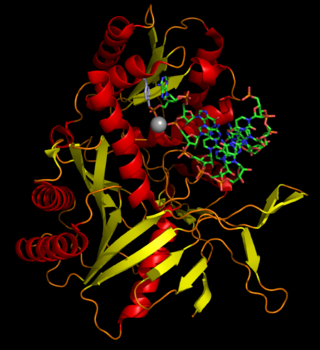
Nanoarchaeum equitans is a species of marine archaea that was discovered in 2002 in a hydrothermal vent off the coast of Iceland on the Kolbeinsey Ridge by Karl Stetter. It has been proposed as the first species in a new phylum, and is the only species within the genus Nanoarchaeum. Strains of this microbe were also found on the Sub-polar Mid Oceanic Ridge, and in the Obsidian Pool in Yellowstone National Park. Since it grows in temperatures approaching boiling, at about 80 °C (176 °F), it is considered to be a thermophile. It grows best in environments with a pH of 6, and a salinity concentration of 2%. Nanoarchaeum appears to be an obligate symbiont on the archaeon Ignicoccus; it must be in contact with the host organism to survive. Nanoarchaeum equitans cannot synthesize lipids but obtains them from its host. Its cells are only 400 nm in diameter, making it the smallest known living organism, and the smallest known archaeon.

Nanoarchaeota is a proposed phylum in the domain Archaea that currently has only one representative, Nanoarchaeum equitans, which was discovered in a submarine hydrothermal vent and first described in 2002.

The Thermoproteota are prokaryotes that have been classified as a phylum of the Archaea domain. Initially, the Thermoproteota were thought to be sulfur-dependent extremophiles but recent studies have identified characteristic Thermoproteota environmental rRNA indicating the organisms may be the most abundant archaea in the marine environment. Originally, they were separated from the other archaea based on rRNA sequences; other physiological features, such as lack of histones, have supported this division, although some crenarchaea were found to have histones. Until recently all cultured Thermoproteota had been thermophilic or hyperthermophilic organisms, some of which have the ability to grow at up to 113 °C. These organisms stain Gram negative and are morphologically diverse, having rod, cocci, filamentous and oddly-shaped cells.

Karl Otto Stetter is a German microbiologist and authority on astrobiology. Stetter is an expert on microbial life at high temperatures.

Archaeoglobaceae are a family of the Archaeoglobales. All known genera within the Archaeoglobaceae are hyperthermophilic and can be found near undersea hydrothermal vents. Archaeoglobaceae are the only family in the order Archaeoglobales, which is the only order in the class Archaeoglobi.
Methanococcus is a genus of coccoid methanogens of the family Methanococcaceae. They are all mesophiles, except the thermophilic M. thermolithotrophicus and the hyperthermophilic M. jannaschii. The latter was discovered at the base of a “white smoker” chimney at 21°N on the East Pacific Rise and it was the first archaeal genome to be completely sequenced, revealing many novel and eukaryote-like elements.

The Desulfurococcales is an order of the Thermoprotei, part of the kingdom Archaea. The order encompasses some genera which are all thermophilic, autotrophs which utilise chemical energy, typically by reducing sulfur compounds using hydrogen. Desulfurococcales cells are either regular or irregular coccus in shape, with forms of either discs or dishes. These cells can be single, in pairs, in short chains, or in aciniform formation.
The Pyrodictiaceae are a family of disc-shaped anaerobic microorganisms belonging to the order Desulfurococcales, in the domain Archaea. Members of this family are distinguished from the other family (Desulfurococcaceae) in the order Desulfurococcales by having an optimal growth temperature above 100 °C, rather than below 100 °C.
Pyrobaculum is a genus of the Thermoproteaceae.
In taxonomy, Vulcanisaeta is a genus of the Thermoproteaceae.
Sulfurisphaera is a genus of the Sulfolobaceae.
In taxonomy, Palaeococcus is a genus of the Thermococcaceae.
In taxonomy, Thermococcus is a genus of thermophilic Archaea in the family the Thermococcaceae.
Aeropyrum is a genus of archaea in the family Desulfurococcaceae.
Pyrodictium is a genus in the family Pyrodictiaceae. It is a genus of submarine hyperthermophilic Archaea whose optimal growth temperature range is 80 to 105 °C. They have a unique cell structure involving a network of cannulae and flat, disk-shaped cells. Pyrodictium are found in the porous walls of deep-sea vents where the temperatures inside get as high as 400 °C, while the outside marine environment is typically 3 °C. Pyrodictium is apparently able to adapt morphologically to this type of hot–cold habitat.
Natronorubrum is a genus in the family Halobacteriaceae.
Caldococcus is a genus of Archaea in the order Desulfurococcales.

Archaea is a domain of single-celled organisms. These microorganisms lack cell nuclei and are therefore prokaryotic. Archaea were initially classified as bacteria, receiving the name archaebacteria, but this term has fallen out of use.
Thermococcus chitonophagus is a chitin-degrading, hyperthermophilic archaeon isolated from a deep-sea hydrothermal vent. It is anaerobic, round to slightly irregular coccus-shaped, 1.2–2.5 μm in diameter, and motile by means of a tuft of flagella.






